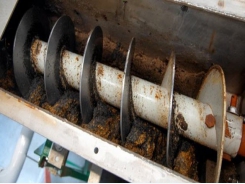Researchers establish testing guidelines for water intake in cattle

Kansas State study indicates potential to select cattle that drink less water and still perform well during times of drought or heat stress.
Kansas State University researchers said they are making steady progress on a study that will help define how water intake relates to a cow’s ability to adapt to drought or heat stress.
Megan Rolf, assistant professor of animal breeding and genetics, said the cattle industry has sparse information on how much water individual cattle drink each day. To date, most research has estimated an animal’s water intake based on an average for an entire pen of cattle, she said.
However, knowing individual differences in water intake could eventually help producers select cattle for genetic traits that make those animals more resilient to drought and heat stress, she added.
“If you’re in an area that has 50 in. of rainfall per year and you have tons of surface water, it’s probably not a big deal and not something you have to think about, but if you’re pumping groundwater to animals or if you’re in an area where there is a drought that particular year and your surface water is being depleted or of poor quality, this becomes more of an attractive trait to think about from a selection perspective,” Rolf said.
“It’s possible that we could select animals to drink less water, which would be valuable in those types of conditions,” she added.
One of the most important accomplishments made by Rolf and her colleagues at Kansas State University and Oklahoma State University is that they have determined testing guidelines for measuring water intake efficiency in cows.
The Beef Improvement Federation (BIF) has test guidelines for such measures as feed intake, but no such guideline exists for water intake, Rolf said. The guidelines set the number of days that are needed to collect reliable data on intake so they can be included in a genetic evaluation of the animal.
For example, BIF has determined that a producer should have 35-42 days of feed intake data to get accurate information on feed efficiency for a given animal or set of animals.
No such guideline exists for water intake, Rolf said, “so one of the first things we needed to do for water intake was to come up with preliminary data. We wanted to establish how many days we actually need to collect data on these animals, because water intake seems to be a bit more variable than feed intake on a daily basis. We hypothesized that this might result in a need to collect more days of data to accurately describe that phenotype,” which is a set of observable traits in the animal, such as average daily weight gain and other performance-based measures.
As it turns out, Kansas State’s work has determined that the same 35- to 42-day period is appropriate for collecting water intake data.
“For regions of the country or to producers who are interested in this type of data, it can be collected in the same time period as dry matter intake data as part of a standard feed intake test,” Rolf said. “We can collect an additional phenotype if a facility has that ability, and I think that is great news.”
The finding does come with some caution, however.
Rolf noted that they have to be mindful of "the relationship between water intake and other economically important production traits. If we were to select for (drought or heat stress tolerance), what would be the downstream implications in terms of the performance of those animals? That’s what we’re working on now.”
Kansas State’s project is funded by the U.S. Department of Agriculture's Agriculture & Food Research Initiative. The project is in the fourth of five years of funding.
Có thể bạn quan tâm
Phần mềm

Phối trộn thức ăn chăn nuôi

Pha dung dịch thủy canh

Định mức cho tôm ăn

Phối trộn phân bón NPK

Xác định tỷ lệ tôm sống

Chuyển đổi đơn vị phân bón

Xác định công suất sục khí

Chuyển đổi đơn vị tôm

Tính diện tích nhà kính

Tính thể tích ao hồ




 Hike in dairy feed demand in Ireland due…
Hike in dairy feed demand in Ireland due…  Cornell dairy barn implements manure separation system
Cornell dairy barn implements manure separation system